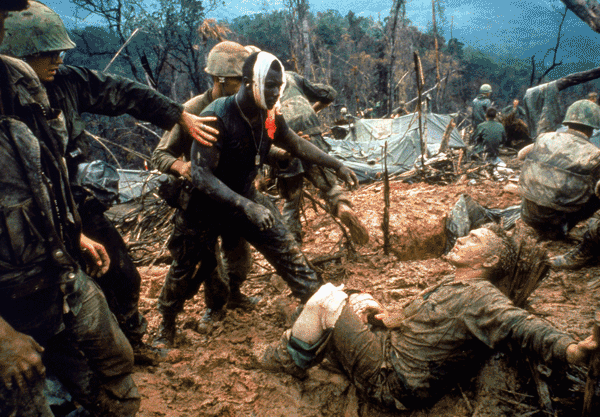The Vietnam War, Ken Burns Documentary (Resolve – Ep. 4, January 1966 – June 1967)
- Moogie, patriotic and believed in “individual freedom”
- “We tend to fight the next war in the same way we fought the last one. We are prisoners of our experience.” – Sam Wilson (1:48:12)
- “Very, very difficult to dispel ignorance if you retain arrogance.”
- Fulbright wanted peace settlement: 1:43:21
- Who killed Ngo Dinh Diem? (should we consider this equation)
- American exceptionalism = superiority
- Was it the false sense of idealism that destroyed hope when reality of war was shattered?
- All the zealous soldiers worshipped WII generation
- All wanted to be a hero or star of their own lives, never conceived losing

Slideshow of the horrors of the Vietnam War
- What was so different about the Vietnam War compared to WWI and WWII?
- Marine Corps trains you to fight […] to kill” (1:33:54)
- “If you’re a Marine, you can’t die until you kill three Vietnamese.”
- Explore effects of PTSD
- Documentary takes after a very American perspective
- Pay attention to specific use of talking heads
- Very few perspectives from South Vietnamese vets
Going After Cacciato by Tim O’Brien
“Hell no, we won’t go!” were amongst the first words uttered at a protest rally on April of 1968 in the central square of New York City. Thousands of Americans marched in unison to display their anti-sentiments towards the Vietnam War with hopes that the government will listen to their demands.
With an estimated 35,000 soldiers drafted per month, Americans were growing increasingly weary of their sons being deployed to a war without end. Even with top-notch/top-tier commanders such as General Westmoreland and McNamara leading these soldiers, they were simply the blind-leading-the-blind into an abyss of death. No amount of training at West Point nor boot camp could fully prepare these men on the battlefield as they were forced to distinguish between the Viet Cong and the South Vietnamese – between guerrilla fighters and innocent civilians.
In Tim O’Brien’s Going After Cacciato, the aforementioned author opens his novel with a surreal and dream-like quality to his characters’ psyche during the Vietnam War. Paul Berlin, the main protagonist, continues to elaborate the backdrop to the Vietnam War, albeit never explicitly referencing the war, including the deaths of those in his platoon in a disturbingly calloused manner.
Quotes:
“Spec Four Paul Berlin: I am asking for a break from violence. But I am also asking for a positive commitment. You yearn for normality – an average house in an average town, a garden, perhaps a wife, the chance to grow old. Give up this fruitless pursuit of Cacciato. Forget him. Live now the dream you have dreamed. See Paris and enjoy it. Be happy. It is possible. It is within reach of a single decision” (O’Brien 318).
-
- The entire platoon consisting of Stink Harris, Bull, Doc Peret, and Corson, all have the objective to bring back Cacciato despite their ambiguity towards his character. Cacciato = embodiment of the Vietnam War The road to Paris symbolizes the yearning for peace and prosperity that American Soldiers had hoped for → Americans wanted the war to be over
- Paris = peace treaties
- Paul Berlin coped with his guilt over killing Cacciato and his complicity to Sidney Martin’s death by filtering his guilt through a prism of hallucinations
- However, Berlin will always experience this trauma and emotional turbulence unless he finally confronts and acknowledges his crimes.
Exploring the effects of PTSD
- Effects of this symptom are worsened through isolation and substance abuse
- How many percentage of veterans with PTSD also had depression?
- How many abused drugs and other substances?
- Vietnam Veterans were scorned and ostracized
- In 1983, the National Vietnam Veterans Readjustment Study (NVVRS) conducted a study showing that as many as 15% of Vietnam Veterans suffered from PTSD
- A longitudinal study in 2013, 7% of females and 11% of males still experience PTSD 40 years after the war
- 37% of those veterans also met the criteria for major depression
- “Two-thirds of Veterans with current warzone-related PTSD discussed behavioral health or substance abuse concerns with providers”
Works Cited
Featured image is of Forrest Gump in boot camp
US Department of Veterans Affairs, and Veterans Health Administration. “Public Health.” PTSD and Vietnam Veterans: A Lasting Issue 40 Years Later – Public Health, 7 May 2015, http://www.publichealth.va.gov/exposures/publications/agent-orange/agent-orange-summer-2015/nvvls.asp.
O’Brien, Tim. Going After Cacciato. First Broadway Books, 1999.
Editors, History.com. “Vietnam War Timeline.” History.com, A&E Television Networks, 13 Sept. 2017, http://www.history.com/topics/vietnam-war/vietnam-war-timeline.
Burns, Ken and Lynn Novick, directors. The Vietnam War . 2017.